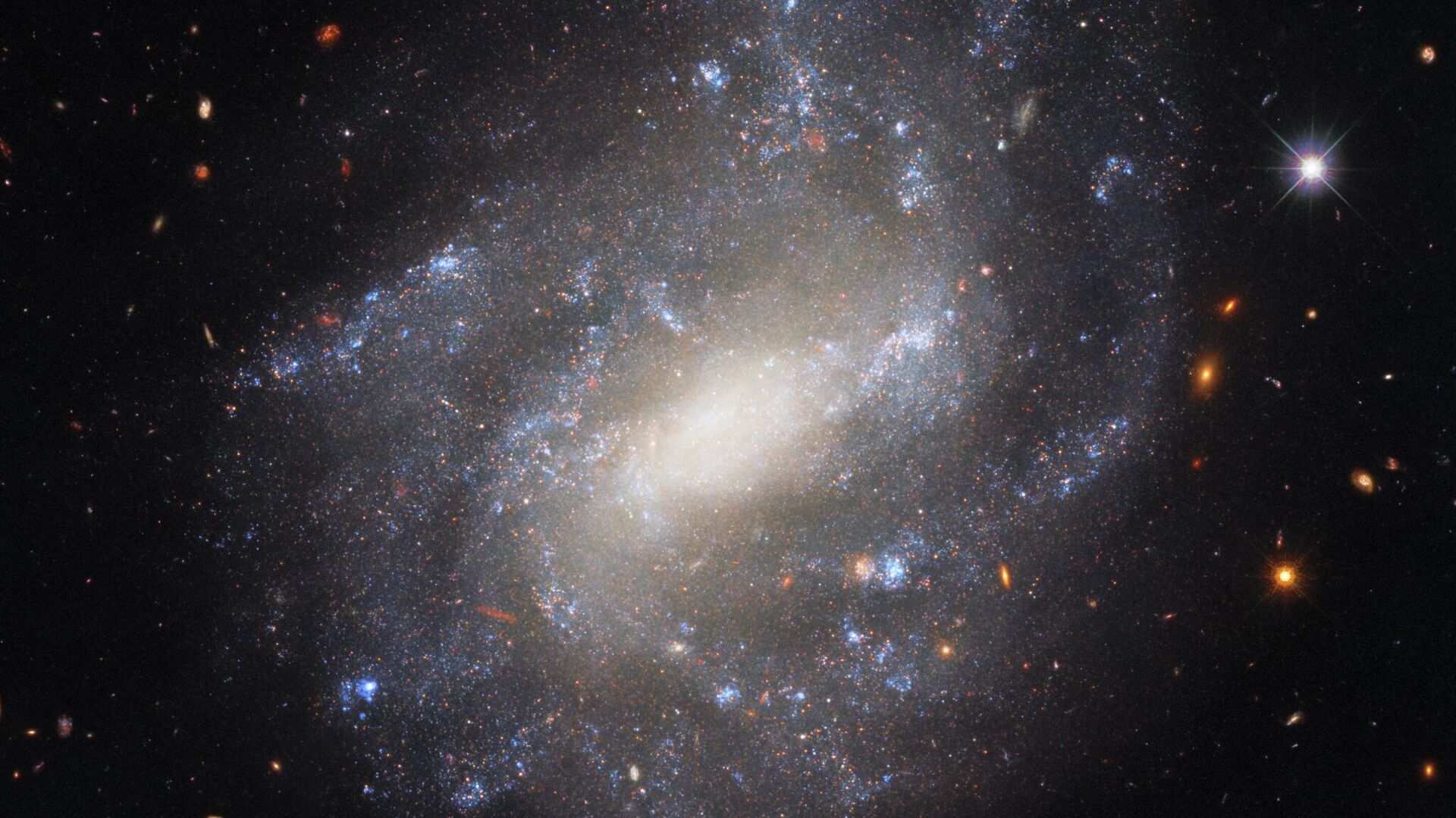https://sputnikglobe.com/20221209/mysteries-of-time-capsule-galaxy-eventually-unveiled--1105268052.html
Mysteries of 'Time-Capsule' Galaxy Eventually Unveiled
Mysteries of 'Time-Capsule' Galaxy Eventually Unveiled
Sputnik International
The galaxy HIPASS J1131-31, also known as Peekaboo, was hiding behind the star TYC 7215-199 that obscured it, effectively preventing astronomers from studying... 09.12.2022, Sputnik International
2022-12-09T10:28+0000
2022-12-09T10:28+0000
2022-12-09T10:28+0000
science & tech
galaxy
dwarf galaxy
big bang
astronomy
hubble space telescope
https://cdn1.img.sputnikglobe.com/img/07e6/0a/1e/1102850937_0:581:2047:1732_1920x0_80_0_0_e07a1acdb982fd183f4cae33adbbf9cf.jpg
The Peekaboo Galaxy has finally emerged after 20 years of hiding from astronomers. It was obscured by a bright star in the Milky Way. When astronomers first discovered Peekaboo, also known as HIPASS J1131-31, in early 2000s, they were able only to study it via ultraviolet observations. These observations revealed that Peekaboo is a compact blue dwarf galaxy, e.g. a formation of young stars dominated by a blue one. However, it was all the information that was available.But the star obscuring Peekaboo was a fast-moving one and it was moving away from the galaxy. For twenty years the gap between the star and the galaxy widened. Nonetheless, technological progress helped, and eventually astronomers were able to study Peekaboo. The astronomers realized that the galaxy is extremely young and extremely close – just 22 million light years away."Uncovering the Peekaboo Galaxy is like discovering a direct window into the past, allowing us to study its extreme environment and stars at a level of detail that is inaccessible in the distant, early Universe," astronomer Gagandeep Anand, Space Telescope Science Institute in Baltimore, says.An international scientific team led by astronomer Igor Karachentsev of the Russian Academy of Sciences decided to take a closer look at Peekaboo. In order to achieve this goal, they used three telescopes: the Hubble Space Telescope, the Southern Africa Large Telescope and the Australia Telescope Compact Array.The observation not only helped to detect 60 stars in the galaxy, but also to determine what these stars were made of. Thus was detected an abnormality – a virtual absence of metals in HIPASS J1131-31."Now, with combined data from the Hubble Space Telescope, the Southern African Large Telescope, and others, we know that the Peekaboo Galaxy is one of the most metal-poor galaxies ever detected," astronomer Bärbel Koribalski, one of the first to discover Peekaboo, says.This low abundance of metals indicates that the object is very old even by galactic standards since metals appeared several billion years ago, after the Big Bang. On the other hand, stars in the galaxy appear to be just a few billions old. This means that Peekaboo can be considered a replica of what the earliest generation of galaxies looked like. As researches point out, it is essentially a “time capsule” and it is practically “next door” from a cosmic point of view.Scientists are now anxious to use the James Webb Space Telescope in order to revisit the galaxy and conduct a more detailed study.
Sputnik International
feedback@sputniknews.com
+74956456601
MIA „Rossiya Segodnya“
2022
News
en_EN
Sputnik International
feedback@sputniknews.com
+74956456601
MIA „Rossiya Segodnya“
Sputnik International
feedback@sputniknews.com
+74956456601
MIA „Rossiya Segodnya“
big bang, galaxy, astronomy, science, stars
big bang, galaxy, astronomy, science, stars
Mysteries of 'Time-Capsule' Galaxy Eventually Unveiled
The galaxy HIPASS J1131-31, also known as Peekaboo, was hiding behind the star TYC 7215-199 that obscured it, effectively preventing astronomers from studying it.
The Peekaboo Galaxy has finally emerged after 20 years of hiding from astronomers. It was obscured by a bright star in the Milky Way. When astronomers first discovered Peekaboo, also known as HIPASS J1131-31, in early 2000s, they were able only to study it via ultraviolet observations. These observations revealed that Peekaboo is a compact blue dwarf galaxy, e.g. a formation of young stars dominated by a blue one. However, it was all the information that was available.
But the star obscuring Peekaboo was a fast-moving one and it was moving away from the galaxy. For twenty years the gap between the star and the galaxy widened. Nonetheless, technological progress helped, and eventually astronomers were able to study Peekaboo. The astronomers realized that the galaxy is extremely young and extremely close – just 22 million light years away.
"Uncovering the Peekaboo Galaxy is like discovering a direct window into the past, allowing us to study its extreme environment and stars at a level of detail that is inaccessible in the distant, early Universe," astronomer Gagandeep Anand, Space Telescope Science Institute in Baltimore, says.
An international scientific team led by astronomer Igor Karachentsev of the Russian Academy of Sciences decided to take a closer look at Peekaboo. In order to achieve this goal, they used three telescopes: the Hubble Space Telescope, the Southern Africa Large Telescope and the Australia Telescope Compact Array.
The observation not only helped to detect 60 stars in the galaxy, but also to determine what these stars were made of. Thus was detected an abnormality – a virtual absence of metals in HIPASS J1131-31.
"Now, with combined data from the Hubble Space Telescope, the Southern African Large Telescope, and others, we know that the Peekaboo Galaxy is one of the most metal-poor galaxies ever detected," astronomer Bärbel Koribalski, one of the first to discover Peekaboo, says.
This low abundance of metals indicates that the object is very old even by galactic standards since metals appeared several billion years ago, after the Big Bang. On the other hand, stars in the galaxy appear to be just a few billions old. This means that Peekaboo can be considered a replica of what the earliest generation of galaxies looked like. As researches point out, it is essentially a “time capsule” and it is practically “next door” from a cosmic point of view.
Scientists are now anxious to use the James Webb Space Telescope in order to revisit the galaxy and conduct a more detailed study.

